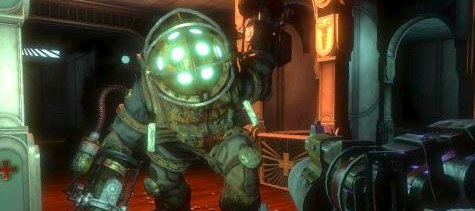-
"I've always marvelled at the idea of a $25m game needing $35m of marketing. Doesn't that feel so wrong and weird? I'd make two $25m games, spend $8m on indies doing crazy new things, and have $2m left over for some nu-style publicity. Or better still, spend $60m across 60 indies full stop." Lots of good things in Alice's compainon to Matt's posts, but especially this; the constant shyness to 'spend less on more stuff' from the games "industry" always befuddles me.
-
Lots of comics neatly surmising the plots of various Metal Gears; "Let's Destroy The Shagohod" is pretty spot-on, start to finish, and full of Giant Spoilers, obviously.
-
"As I tried to unravel Braid’s interstitial text I realized that solving the puzzles and understanding the text required very similar approaches. Their concealed machinations and thematic ambiguities are teased out using the same mental processes, and are part of the same overarching search for meaning. In a way, I was “reading” everything in the game. It’s not the unification of narrative and gameplay that we’ve come to expect, but it’s a refreshing and effective one." Dan Bruno has an interesting perspective on Braid; not sure I agree with it entirely, but the feelings he describes are certainly familiar.
-
So I'm going to be writing the odd thing for Offworld from time to time, and this is my first post, on a nice post from Steve Gaynor about architecutre, and leading players through stories with architecture alone. More to come, pop-pickers.
-
'London police are now deleting tourists' photos because "photographing anything to do with transport is strictly forbidden."' Oh god.
-
"Protovis is a visualization toolkit for JavaScript using the canvas element. It takes a graphical approach to data visualization, composing custom views of data with simple graphical primitives like bars and dots."
-
"[within the games industry]… the creativity-medium-invention and attitude-practice-deconstruction models often hold no water. Rather, there is only importance placed upon the “talent-meiter-immitation” model that is still in practice in the industry today." An interesting analysis of the nature of education (as it relates to the games industry) and models of learning. I have often lamented the depressing state of how career progression in the industry works, and this article helps quantifies it.
-
A thoughful post (as ever) from the L4D team detailing some of the balancing and planning that's gone into the Survival Mode experience. Looking forward to firing this up next week…
-
"The genre of the palindrome, playful and ludic as it is, nonetheless has a strong implication of violence. In the work of its foremost practitioners, Velemir Khlebnikov and Vladimir Nabokov, as well as some of their postmodern successors, the palindrome is closely linked to death, cannibalism, beheading, and murder."
-
Tom Francis posits an alternate ending to Bioshock, that makes sense of the Vita-Chambers switcheroo, gives the player the agency they've craved, fixes some of the issues with the original ending, and asks you kindly to DROP THE GODDAMN RADIO.
-
"These sketches should make Arduino-based web-controlled home automation, and remote-responsive spaces a lot easier. The advantage of working with an ethernet shield is that you no longer need to tether the Arduino to a computer in order to access Pachube and other network services!" Some useful examples, to be returned to.
-
"In one moment the game had broken the tacit agreement between us. It had failed to respect my character decisions, it had made a pretense of allowing me to define whether Faith violent or not only to pull the rug away at the vital moment and strip all control from me. It lied. Any actions I might have taken to avoid combat up to then were for nothing. It had failed to show me respect so had lost mine." Breaking the unwritten contract with the player is definitely a bad thing, and I didn't notice this – but only because I'd not been aiming for the "no kills" achievement.
-
Japanese Bioshock commercial. Nifty: no in-game footage, but there's something that feels like it overlaps right.
Back to Bioshock
27 July 2008
or: trust the designer, not the mechanic.

I have a problem with not finishing games. I doubt I am the only one. But sometimes I become disappointed with my inability/lack of time to finish a game, and Bioshock is one title I’m disappointed not to have put more time into.
Most games stop being played either because my interest wanes or beacuse they demanded too much time. Bioshock did neither. Bioshock was, whilst I was playing it, wonderful: simple mechanics, but deep design; beautiful architecture; solid story-telling.
I was really enjoying it, and really into it – and then we broke up. We broke up because of what it asked me to do.
Continue reading this post…
Ken Levine on BioShock
12 May 2006
Ken Levine, creator of System Shock 2, talks to IGN about his forthcoming RPG Bioshock. Two choice quotations:
I’ve always said that, when we were working on Thief, I’d rather have a story element about the moss arrow then about some cult you never get involved with in the game or some god or something. That’s because I play with the moss arrow, it’s part of my game experience; I want to tie that into the story.
and
I think it’s all about making a world that’s believable. One that has an aesthetic point of view in which the player isn’t constantly bumping into the edge of thus pulls him out of the experience. It’s not about physics puzzles, it’s about having things behave the way I expect them to. Half-Life 2 uses physics puzzles really well; that’s not an issue. My response is not to create my own gravity gun. Our goal is to make this world in Rapture a real place.
Yes. Yes, yes, yes. More sharp, incisive, intelligent discussion in the full interview.